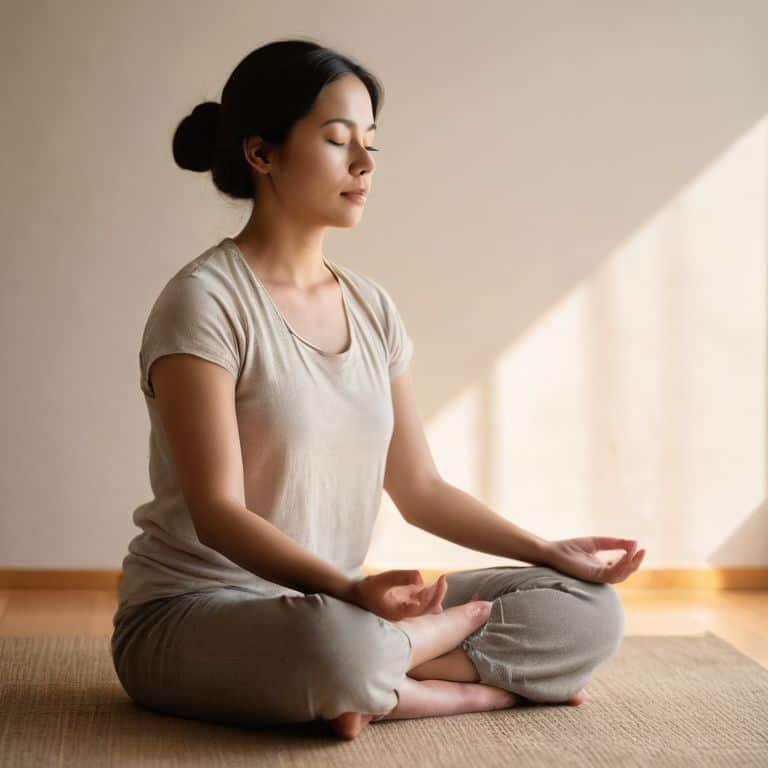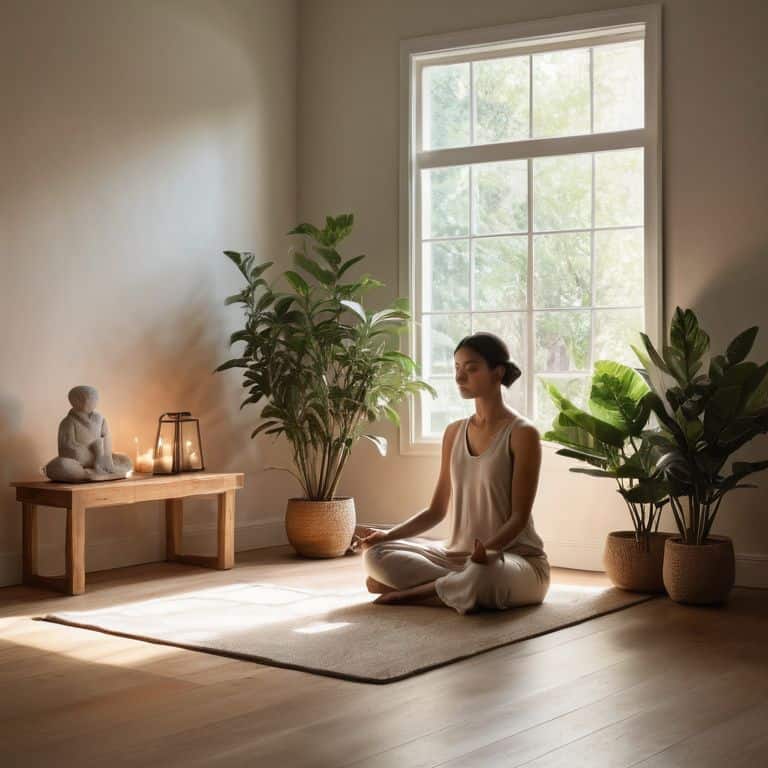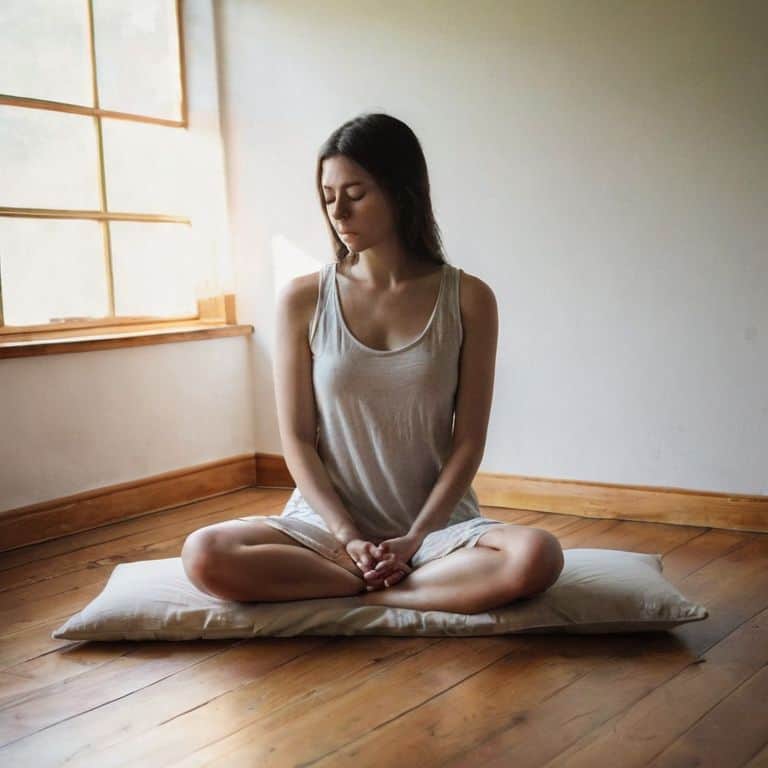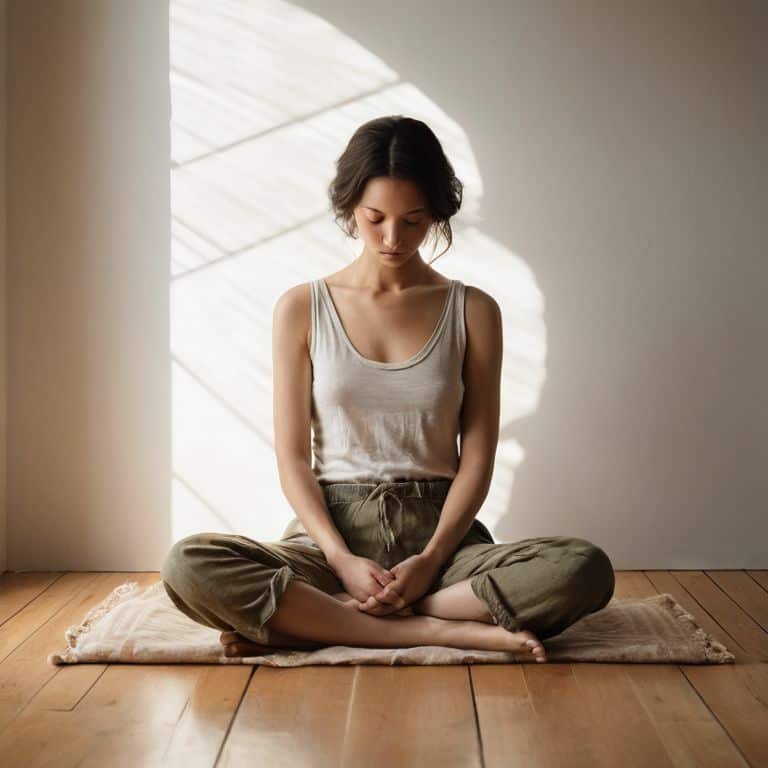Take a deep breath in, and as you exhale, allow your body to relax. As I sit here, surrounded by the serene beauty of nature, I’m reminded of the common misconception that how to sit for meditation requires a specific, rigid posture. Many of us have been led to believe that we need to sit in a perfect lotus position, with our backs straight and our minds empty, in order to truly meditate. But I’ve found that this approach often leads to more tension and frustration, rather than the peacefulness we’re seeking.
As we explore the world of meditation together, I want to assure you that this guide is not about achieving some kind of ideal meditative state. Instead, it’s about discovering a simple, practical approach to how to sit for meditation that works for you, in the midst of your busy life. In this article, I’ll share my personal experience and insights on how to create a comfortable, inviting space for meditation, and provide you with gentle, step-by-step guidance on how to sit in quiet contemplation, allowing you to cultivate a deeper sense of inner stillness and peace.
Table of Contents
Guide Overview: What You'll Need

Total Time: 10 to 30 minutes
Estimated Cost: $0 – $20
Difficulty Level: Easy
Tools Required
- Cushion or Pillow (for support)
- Wall or Back Support (optional)
Supplies & Materials
- Comfortable Clothing
- Quiet Space (free from distractions)
Step-by-Step Instructions
- 1. To begin our meditation journey, let’s start by finding a quiet space where we can sit comfortably without distractions. This could be a corner in your home, a peaceful outdoor spot, or even a meditation room. Take a moment to notice the surroundings and allow yourself to feel grounded.
- 2. Next, choose a seat that feels like home, whether it’s a cushion on the floor, a chair, or a meditation bench. The key is to find a position where you can maintain a straight spine, allowing your breath to flow freely. Experiment with different seating options until you find what works best for you.
- 3. Now, let’s focus on our physical alignment. Place your feet firmly on the ground, with your knees at or below hip level. If you’re sitting on a cushion, you can cross your legs or ankles, whichever feels more comfortable. Remember, the goal is to be relaxed and aware of your body.
- 4. As we settle into our seat, bring your attention to your hands. You can place them on your lap, with your palms facing down or up, or rest them on your knees. The position of your hands can affect your overall posture and energy, so take a moment to find a placement that feels calming and natural.
- 5. With our physical foundation established, let’s turn our attention to our breath. Take a deep inhale, feeling the air fill your lungs, and then exhale slowly, allowing any tension to release. As you breathe, bring your focus to the sensation of the breath moving in and out of your body.
- 6. As we sit in stillness, allow your gaze to soften. You can keep your eyes lightly closed or focus on a point in front of you, about 4-6 feet away. Avoid staring intensely, as this can create tension. Instead, cultivate a gentle awareness of your surroundings.
- 7. Now, take a moment to set an intention for your meditation practice. This could be as simple as dedicating your practice to yourself or others, or acknowledging a personal challenge you’re facing. Having a clear intention can help you stay focused and motivated throughout your meditation journey.
Sitting in Serenity

As we settle into our meditation practice, let’s focus on creating a serene atmosphere that fosters inner peace. This can be achieved by carefully considering our meditation room decor ideas, ensuring that the space is calm and free from distractions. For instance, opting for floor seating options, such as a cushion or mat, can help us connect with the ground and feel more grounded.
When sitting in meditation, it’s essential to maintain a comfortable position, which is where back support for meditation comes into play. For those who prefer cross-legged meditation, using a supportive cushion or pillow can help alleviate any discomfort or strain. Additionally, being mindful of our posture can help us stay focused on our breath, allowing us to fully immerse ourselves in mindful breathing exercises.
As we continue to explore the world of meditation, it’s helpful to keep in mind that meditation for beginners tips often emphasize the importance of starting small and being gentle with ourselves. By incorporating these tips into our practice, we can cultivate a deeper sense of calm and clarity, allowing us to navigate life’s challenges with greater ease and inner stillness.
Cross Legged Calm Benefits
As we settle into our serene seat, let’s explore the benefits of sitting cross-legged. This traditional posture allows our body to relax, while our mind remains alert. By gently crossing our legs, we create a sense of stability and grounding, which can help calm our nervous system.
Sitting in this way can also promote a sense of inner balance, as our body finds a natural equilibrium. With each breath, feel the calmness spread through your body, from the crown of your head to your toes, and allow yourself to settle deeper into the present moment.
Mindful Breathing Basics
As we settle into our serene seat, let’s bring awareness to our breath. Take a deep inhale, feeling the air fill your lungs, and exhale slowly, allowing any tension to release. Now, gently focus on the sensation of each breath, without trying to change it. Notice the rise and fall of your chest or belly, the sensation of the air moving in and out of your nostrils.
Allow your breath to become an anchor, grounding you in the present moment. If your mind wanders, softly bring your attention back to the breath, without judgment. With each inhale, imagine fresh calmness entering your body, and with each exhale, imagine any stress or worries leaving. As you breathe, remember that this gentle rhythm is always available to you, a constant companion in your journey towards inner stillness.
Embracing the Art of Seated Meditation: 5 Gentle Tips
- Let your seat be a foundation, not a restriction, allowing your body to relax and your mind to unwind
- Choose a posture that feels authentic to you, whether on a cushion, a chair, or a bench, making sure your spine is long and your heart is open
- Experiment with different seated positions, such as cross-legged or kneeling, to find what brings you the most comfort and stability
- Remember, the goal of seated meditation isn’t to achieve a specific pose, but to cultivate awareness and kindness towards yourself, just as you are
- Allow your eyes to gently close, or focus on a point in front of you, letting your gaze be soft and your attention be present, as you breathe into the stillness
Embracing the Essence of Meditative Seating
Allow yourself to settle into a seated position that nurtures comfort and stability, letting go of tension as you breathe in tranquility
By embracing mindful breathing and the serene ambiance of your surroundings, you can transform the act of sitting into a profound meditation practice
As you sit in stillness, remember that the goal isn’t to achieve a specific state, but to gently return to the present, embracing each moment with kindness and awareness
Sitting in Stillness
As we sit, may our bodies become the earth that grounds us, our breath the sky that frees us, and our minds the space where serenity and clarity unfold.
Elara Keane
Embracing the Stillness

As we conclude our journey on how to sit for meditation, let’s reflect on the essential elements we’ve explored. We’ve discussed the importance of finding a comfortable seated position, whether on a cushion on the floor or on a chair, and how this simple act can be the foundation of a profound practice. We’ve also delved into the mindful breathing basics, understanding how the breath can be our anchor to the present moment, and touched upon the cross-legged calm benefits that can arise from embracing this traditional seating arrangement. By incorporating these elements into our daily meditation practice, we open ourselves up to a deeper sense of inner peace.
As you embark on your meditation journey, remember that the goal isn’t to achieve a specific state, but to cultivate awareness and kindness towards yourself. With each breath, you’re not only calming your mind and soothing your body, but also embracing the stillness that resides within you. May your practice be a sanctuary, a reminder that no matter the chaos outside, you have the power to create serenity within. And as you rise from your meditation seat, may you carry this sense of calm and clarity with you, weaving it into the fabric of your daily life.
Frequently Asked Questions
What is the most comfortable seated position for meditation if I have knee or back problems?
Let’s explore options that gently accommodate your needs. For knee or back issues, consider sitting on a chair or using a meditation bench with back support, allowing you to maintain a straight spine while easing discomfort.
How long should I sit in stillness before I start to feel the benefits of meditation?
Take a deep breath in, and as you exhale, allow your curiosity to settle. The timeframe for feeling meditation’s benefits varies, but often, just 5-10 minutes of daily stillness can bring a sense of calm and clarity, nurturing a deeper connection with your inner self.
Can I meditate sitting in a chair if I'm not flexible enough to sit cross-legged on the floor?
Absolutely, you can meditate sitting in a chair. In fact, it’s a great option if cross-legged seating feels uncomfortable. Simply find a chair with a straight back, plant your feet firmly on the ground, and gently close your eyes. Take a deep breath in, and as you exhale, allow your body to relax, feeling the support of the chair beneath you.
